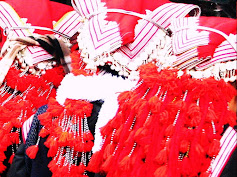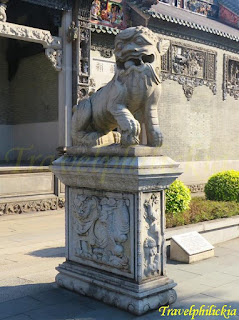Took metro to 'Haizhu Square' station for my breakfast.
Tao Heung Restaurant • Qiaoguang outlet (稻香酒家 • 侨光店)
This restaurant is located on the second floor of Hotel Landmark Canton (华厦大酒店) and is just 5-minutes' walk from the metro station exit (left photo below). Probably still early, I managed to get myself a table at a side corner of the restaurant (right photo below).

 Orders could be first made by selecting the desired dim sum on the paper menu provided. Once completed, just hand the menu over to their stuff. After some confirmation, the restaurant stuff would then enter the orders into their system and a receipt would then be printed (left photo below). Additional orders or final bill payment could be made by scanning the QR code on the receipt.
Orders could be first made by selecting the desired dim sum on the paper menu provided. Once completed, just hand the menu over to their stuff. After some confirmation, the restaurant stuff would then enter the orders into their system and a receipt would then be printed (left photo below). Additional orders or final bill payment could be made by scanning the QR code on the receipt.To start off, got myself of pot of Chinese tea 'Tie Guan Yin' (right photo below).


After some waiting, my four dim sum dishes finally arrived. To be exact, they were shrimp rice noodle roll (left photo below), steamed chicken feet (right photo below), shrimp dumplings (bottom left photo), and red-rice noodle roll (bottom right photo).




Taste was good and fulfilling as usual and total cost was CNY 72. Do note that there were discounts at half-price for the dim sum dishes.
| 🍔 Tao Heung Restaurant • Qiaoguang brunch (稻香酒家 • 侨光店) | |
|---|---|
| Address: | 2/F, Hotel Landmark Canton, Qiaoguang Road (侨光路8号华厦大酒店2楼A,C座) |
| Access: | Haizhu Square Station (海珠广场站) of Line 2 and Line 6, Exit A |
| Operating Hours: | 0800 hours to 2300 hours; daily |
I then took metro to 'Chen Clan Academy' station.
Chen Clan Ancestral Hall (陈家祠堂)
The Chen Clan Ancestral Hall is a must-see destination in Guangzhou. Also known as the Chen Family Academy, this stunning complex is one of the finest examples of Lingnan (Southern Chinese) architecture and a treasure trove of intricate carvings, sculptures, and folk art.
A Glimpse into History
- Built between 1890 and 1894 during the Qing Dynasty, the Chen Clan Ancestral Hall was originally a family temple and academy for the Chen family, one of Guangdong's most prominent clans. It served as a place for ancestral worship, education, and gatherings for Chen descendants from across the province.
In 1959, it was converted into the Guangdong Folk Art Museum (广东民间工艺博物馆), showcasing an impressive collection of ceramics, wood carvings, and other traditional crafts. It was later added in the list of "Cultural Relics of National Importance under the Protection of the State" in 1988.
Complex Structure and Layout
- Head-entrance (頭門)
The head-entrance is 27.56-meters wide and 14.91-meters deep with 17 columns (left photo below), and decorated with exquisite flowers and figures (right photo below).
Standing in front the entrance is the pair of over 2-meters tall stone lion with its pedestal (photos below).
On top of the gate of the entrance hangs a tablet with words "Chen Clan Academy" (陳氏書院) (left photo below). Behind this main entrance is the four double-sided engraved screens (right photo below).

- Gathering Hall (聚賢堂)
The Gathering Hall was once a place for meeting and worship of the Chen clansmen. It is 27.84-meters wide and 16.7-meters deep with 21 main beams and 6 carved stone columns (left photo below). Similar to the head-entrance, its ridge crest is fully decorated with flowers and figures (right photo below).
At the back of the hall sit the sixteen double-sided engraved folding screens (photos below).

- Back Hall (後堂)
In the Back Hall, memorial tablets of ancestors were placed on a 21-step shelves (left photo below). On the top of the shelves are 7-meter-high wooden-carved niche covers (right photo below).
- Courtyards and Corridors
Buildings are separated with "Qingyun alleys" (青雲巷) and connected by corridors between the courtyards (photos below).
Architecture Highlights
- The Chen Clan Ancestral Hall is renowned for its exquisite craftsmanship, blending wood, stone, and brick carvings with ceramic and iron decorations.
- Plaster Sculptures
Found mostly on the bases of the ridges and roofs of the corridors that stretches a total length of 1800-meters. The plaster carvings in the Ancestral Hall were example of exquisite plaster art where some were made as they go through the wall, while some come out up to 60-cm from the wall giving a three-dimensional effect (photos below).
- Pottery Sculptures
One of the most distinguished features of the Ancestral Hall is the 11-pottery ridge crest, which was installed on the nine great halls of the academy. The tip of the ridge crests is the pair of flying cods, which were believed to be a half-dragon half-fish creature (photos below).

These flying cod figures have tentacles reaching out from the roof to the sky which make the profile of the building more elegant (photos below).
- Wood Carvings
The Ancestral Hall has a large collection of wood carvings, which can be seen everywhere in the halls at the corners of the beams, walls, and doors. In the head-entrance sit the four double-sided pieces of exquisite engraved screens describing historical and legendary stories (photos below).
- Stone & Brick Reliefs
These stone and brick reliefs lie mostly in the inner walls of each great halls (left photo below). - Iron Castings
Used mainly on platform railings, these dark-colored engravings have symmetric patterns of four different themes (right photo below).

| 💡Travel Trivia: |
- Beyond its architectural beauty, the Chen Clan Ancestral Hall houses a museum with fascinating folk art exhibits. Exquisite wooden artworks from various parts of Guangdong are displayed in this museum. One good example are the carved wooden scared pavilions made during the late Qing dynasty and Republic period (photos below).


Another fine specimen is the pair of "gold-lacquered and colored woodcarving lion brace" (photos below) and "gold-lacquered woodcarvings" (bottom photos).




In traditional Lingnan architecture, carved decorations are mainly applied to the house frame structure. This museum showcases the finest woodcarvings (left photo below) and stone carvings (right photo below).


- The exhibition offers a fascinating glimpse into the rich cultural and historical heritage of Guangzhou (formerly known as Canton). It allows visitors to have an immersive experience, step back in time and witness the lifestyle of Guangzhou's elite. Major attractions include courtyard layouts designed for ventilation, stained-glass windows influenced by Western styles, and antique furniture made from precious rosewood and mahogany (photos below).




Instagrammable Spots
- With keen eyesight, many instagrammable spots can be identified in the Chen Clan Ancestral Hall, such as the brick walls with contrasting lighting (left photo below) and the vibrant colors of unusual figurines on the roof ridges (right photo below).


Left this academy at about 11.30 pm.
| 🎫 Chen Clan Ancestral Hall (陈家祠堂) | |
|---|---|
| Website: | https://weibo.com/gdmjgybwg |
| Access: | Chen Clan Academy Station (陈家祠站) of Line 1 and Line 8, Exit D. |
| Opening Hours: | 0900 hours to 1730 hours. Closed on Tuesdays. |
| Admission: | CNY 10 (Adult). |
Xihua Road Food Street (西华路美食街)
Xihua Road food street is a 600-meters long popular destination with many long-standing restaurants and stalls for locals and tourists seeking authentic Cantonese dishes (left photo below). Unlike most touristy food streets, Xihua Road retains a local charm, offering affordable and high-quality dishes that have been perfected over generations (right photo below).

 The Xihua Road Food Street can be reached from Caihong Bridge Station (彩虹桥站) Exit A of Metro Line 8 and 11.
The Xihua Road Food Street can be reached from Caihong Bridge Station (彩虹桥站) Exit A of Metro Line 8 and 11.Must-Try Dishes and Restaurants
- From dim sum and roast meats to noodle soups and desserts, every bite tells a story of Guangzhou's rich culinary heritage. Following is the list of recommended stores based on the several Food Bloggers and YouTubers.
Gentle Reminders on visiting
- Following are some reminders on visiting this food street:
• Bring cash in view of the fact that some small eateries don't accept digital payments.
• Explore side alleys since hidden gems often lurk in unassuming corners.
• Go hungry because there are so many options along the street, so definitely want to try a bit of everything!
Sampled Food
- It was closed to lunch time so I decided to sample some cuisines along this famous food street.
- 荔林食店
This restaurant has sufficient indoor seatings with some outdoor seats (left photo below). As its signboard suggested, the signature dishes are fresh meat, fish, beef brisket, and pork offal. I then ordered its famous "Supreme Three Treasures Rice Noodles" (至尊三宝捞河粉) at CNY 28 (right photo below) since it was highly recommended from a local food blogger.
The "tree treasures" includes 'first meat' (第一刀肉) which was some delicious marinated pork, 'beef tendon' (牛筋) that was so slippery and I almost could not pick them up using chopsticks, and the 'fish meat' (鱼滑) which could taste its freshness and tenderness. All the meat pieces were so tasty that I finished all of them except for the rice noodles that I left half a bowl.
🍔 荔林食店 Address: Xihua Road No. 165, Liwan District, Guangzhou Access: Caihong Bridge Station (彩虹桥站) of Metro Line 8 and 11, Exit A. Operating Hours: 0730 to 1600 hours; daily - 芝麻糊世家
This restaurant keeps pace with the times and has recently renovated its store with popular decoration. In addition to the high quality of sesame, their production process is also exquisite. Sesame paste is hand-pounded, the pounding stick is made of fruit trees unique to Lingnan, and the sand basin has been used since their early generations (left photo below).
There are four flavors to choose from; sesame, peanut, almond and walnut. Customers can mix and match if wanted to try more flavors. I ordered a sesame almond paste at CNY 9 and the shape is almost a "Bagua Tai Chi" diagram (right photo below).
The sesame paste is very thick and sticky. The sweetness is just right. It tastes not only smooth and dense, but also has the unique granular texture of sesame, which is completely incomparable to the sesame paste sold in sachet packs.🍔 芝麻糊世家 Address: Xihua Road No. 385-2, Liwan District, Guangzhou Access: Caihong Bridge Station (彩虹桥站) of Metro Line 8 and 11, Exit A. Operating Hours: 1030 to 2300 hours; daily
After a good lunch, I then walked towards Guangxiao Road.
 Posts RSS
Posts RSS





































